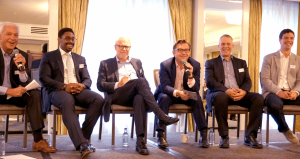Private Equity: New Perspectives on Driving Value with Digital
18 September 2018 by Jack Denison
La Fosse Private Equity hosted a panel discussion, for both investment professionals and leaders of their portfolio businesses, to explore how investment professionals can drive value with digital beyond customer engagement.
The discussion was facilitated by Jonathan McKay, Chairman of La Fosse Associates, Forward Partners and CBNL, and former Chairman of JustGiving. The panel included the following high-profile business leaders:
Panellists:
• Colin Tenwick – Chair of Addison Lee, Wowcher, Picsolve and ATG
• Mark Holt – Chief Technology Officer of The Trainline
• Charlie Cannell – Digital Director of Inflexion Private Equity
• David Germain – Group CI&TO of RSA Group
• Steve Goodwin – Chief Transformation Officer at William Hill

‘What it all comes down to is people, process and productivity. It’s nebulous, it’s difficult, it’s not spreadsheetable – but these are the critical factors.’ Charlie Cannell, Digital Director for Inflexion
‘Digital transformation’; the phrase has cemented itself in corporate parlance, a regular guest in conferences and conversations across the investment spectrum. However, these conversations tend to focus on recurring themes, using examples from well-trodden sectors – too often when we speak of digital, we just mean ‘online’, and more often than not ‘e-commerce’.
La Fosse Associates recently produced a white-paper interviewing Private Equity professionals on the most effective strategies when driving value with digital in non ‘native’ industries, looking at how to streamline, upskill, integrate, and ultimately add value beyond user-experience.
Building on these insights, we hosted ‘Driving Value with Digital’; an event exploring how digital can be optimised across all aspects of the business. Here, we explain why Mark can’t sleep at night, why Steve is betting on the High Street, and why Charlie has a group of Digital specialists he doesn’t actually employ – along with other key takeaways from the panel.
Think ‘People, Process, Productivity’ not ‘UX, UX, UX’
You need to be completely in control of your product value-chain end-to-end. Though one event attendee observed that the CMO is increasingly the biggest tech-spender at an organisation, Charlie finds, on a surprising number of occasions, he has to introduce tech to marketing. ‘75% of my job is connecting them and making sure that the processes which allow them to collaborate work’. David Germain agreed, suggesting that he ‘challenges’ the CMO to look beyond client-facing and focus on digitising client journeys end to end.
Mark highlighted that at Trainline, collaboration is a structural priority: they purposely separate the organisation into small cross-functional teams where product people, user-interface people, marketing people and developers work together towards one OKR. ‘Innovation and inspiration can be tricky to encourage in a large organisation across disparate teams, but comes much easier to a small group of highly-motivated, collaborative individuals working towards one common goal.’
Steve highlighted that whilst a digital vision and focus is key, you need to work with your whole organisation, without forgetting bricks and mortar. If William Hill took the decision to abandon all of their traditional betting shops for the betting ecommerce model, they would alienate a huge segment of their customer base – but what technology can do, is optimise integration with their customers in store.
Stop seeing technology as a sunk cost and make your developers stay
The holy grail of a technology team is a permanent group of engaged employees – anything that you regard as a core capability needs to be being built in-house.
However, trying to pull one of these together will cause you a lot of stress, not to mention add significant cost: tech careers now pay 44% higher than the national average wage, with London paying the highest salaries. This is particularly true in the London market, where sky-rocketing salaries are becoming an – albeit anecdoteworthy – norm. Mark Holt proffered the story of recently offering a developer with 5 years’ experience what most would regard as a decent salary – 90k – only to hear that he had accepted an offer from a competitor for 180k.
Outsourcing is one option; be clear on your business strategy and rational to outsource. David highlighted that this move strips the engagement, creativity and effectiveness of the teams, who won’t feel part of the company ‘story.’
Ask where you want the business to be in 3-5 years, and what elements need to be built in-house to get there. This doesn’t necessarily mean owning infrastructure – both David and Mark highlighted that they were very happy to have a cloud solution situated with a specialist organisation – but to become market-leading and maximise agility, you need to be developing your product end-to-end.
One option to ease this change is to initially transition into a hybrid solution. Colin sited Addison Lee, who currently operate as 20:80 outsourced:in-house. Bringing in an SI may seem attractive, but this is rarely a solution which promotes innovation. Ultimately the same agencies are approached by your competitors, and a cookie-cutter approach won’t put you ahead of the curve, but leave you precariously balancing on it.
It’s crucial to look past the cheque-book towards future value. Treating technology as a sunk cost will not sustain your business for long – as a wise CIO once said ‘if you outsource your brain, you’ll outsource your wallet if you’re not careful.’ You may need to drive a cultural shift to change this attitude.
Explore alternate sourcing strategies in the mean-time
Furthermore, bringing teams in-house is the only way to ensure you will attract top-tier talent. ‘You’re not going to gain a reputation as a cool dynamic organisation and attract superstar talent if you outsource all of your developer or engineering teams.’ Pointed out Mark.
Needing to bring talent in-house to secure top talent may seem a chicken-and-egg scenario, but your sourcing strategy needn’t rest resolutely on permanent hiring.
Building a matrix of contractors can be a great solution, particularly in transformative projects where their depth of experience will help drive innovation, creativity and efficiency. Of course, it’s also crucial to create a long-term sourcing strategy for permanent talent, using contractors to supplement.
The Due Diligence box-ticking exercise: and why this mindset will end in failure
Because the ‘big logos’ of consulting tend to steer clear of the mid-market, much of UK PE is under-advised. Nonetheless, when it comes to technical due-diligence, it’s imperative you move beyond box-ticking. This can’t be a case of commissioning a report which no-one reads properly, only to culminate in half a slide in the investment case which reads ‘the tech is ok.’
Reports are a body language indicator, but the most important step is to get inside the organisation – and not just the deal team. Use an Interim specialist pre-acquisition and work with them to run a comprehensive digital health-check, assessing everything from the agility of the management structure, to their cyber-security protocols, to what the processes connecting customer experience with tech-stack are. These findings should form the basis for your investment strategy, and be given the same priority which you grant to financial surveys. It’s worth noting that a ‘red flag’ at this stage needn’t equate to a reason not to invest, but could equally represent an opportunity for optimisation. However, it’s imperative to know where you stand before you can capitalise.
Where there is an Interim, there is a way
Maintaining alignment when driving digital strategy with multiple stakeholders can be contentious. ‘Most PE houses are allergic to headcount’ observed Charlie ‘so they’re unlikely to want to build up large benches.’ Build a map about how you plan to approach digital transformation and then work out where the skills gaps are and how you plan to fill these gaps with a range of third party organisations.
The deployment of Interims is easy to align with the investment committee’s requirements. There’s a happy coincidence between the normal 2-3 year term of an Interim manager and the length of an investment cycle.
What’s more, the market has now matured to a place where there are senior digital professionals who are more than happy to work a few days a month in a portfolio on an advisory basis – it’s worth building a digital associate network to parachute into your portfolio, as Charlie has done.
Keep your friends close, and your regulators closer
‘In order to put out products in the marketplace or innovate around your existing products, you have to have the regulator onside from day 1,’ said David. Bring the regulator into the hub from the beginning to showcase your concepts and ask for feedback, then at every key milestone through the chain of delivery to ensure you don’t have to come up against them later on down the line – don’t leave it as an afterthought.
Colin Tenwick concurred, observing that this was particularly important at a time when regulation is often struggling to keep up with developing business models, citing the example of Addison Lee and the recent debate over how to regulate the emergent gig economy.
Taking this one step further, in many cases it’s highly beneficial to look on regulation as an opportunity rather than a restriction. ‘I love regulation because, once you’ve reached the other side, then you’re protected.’
Pointed out Charlie Cannell. Mark Holt agreed, observing that there was a certain scale which is required to be able to effectively support much regulation – this has the effect of building a ‘moat’ around incumbents, as it’s more difficult for new, smaller entrants to disrupt the market.
If anything should keep you awake at night, it’s security
Whether you’re outsourcing, adopting or innovating the relevant technologies, security needs to be the crucial design principle for your architecture moving forward. It’s business-critical to not only understand the who is trying to hack into your enterprise and what they have to gain, but also have an operating model which allows you to monitor threats as a continuous process. David Germain cited he had repurposed a significant sum to enhance and further harden protection across RSA’s perimeter, and redefined their operating model to include CISOs and cyber-security teams across every region.
Have a disaster plan ready, and carry out a live rehearsal of it. This need include not only your response to the tech, but also your PR strategy. Colin Tenwick observed that crisis management can have a drastic impact on the valuation of a business, as when Talktalk’s CEO struggled to comment on the company’s breach. This feeds into the common observation that organisational education is a crucial part of digital transformation. Steve built on this point; ‘You can surround yourself with as much technology as you want, but one of the most important things is ensuring that every member of staff knows what the security protocols are and how they should be implemented, whether they’re a cashier or a developer. If this isn’t the case, then it’s not been implemented correctly.’
‘These types (and quality) of events create a high degree of valuable awareness in the tech sector. Well done.’ Keith Cornell, Chairman and CEO
‘Excellent event! I am usually sceptical on panel events but this was very interesting and well chaired!’ Investment Director, Baird Capital
‘A quality, genuine debate – both relevant and of value – great event and a rarity as such.’ CIO, Bridgepoint-backed Portfolio Business
For more information:

Jack Denison
Director - Global Head of Executive Search and Interim Management